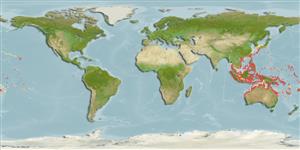Environment: milieu / climate zone / depth range / distribution range
นิเวศวิทยา
เกี่ยวกับทะเล,น้ำเค็ม เกี่ยวกับหินโสโครก; ระดับความลึก 1 - 30 m (Ref. 86942). Tropical; 38°N - 26°S, 96°E - 148°W
Indo-Pacific: Myanmar to the Society Islands.
ขนาด / น้ำหนัก / Age
Maturity: Lm ? range ? - ? cm
Max length : 115 cm TL เพศผู้/กระเทย; (Ref. 90102)
Short description
สัณฐานวิทยา | ความยาวต่างๆ
สัตว์มีกระดูกสันหลัง: 155 - 157. Body pale, almost white, with dark snout (Ref. 48635) and distinctive marking on back of head.
Inhabits muddy to sandy inshore areas and occasionally forages in the open at night (Ref. 637). Burrowing species (Ref. 75154). Caught rarely with gill net from the muddy shallow bottoms of Ryukyu Islands (Ref. 637). Nocturnally active (Ref 90102).
Life cycle and mating behavior
วัยเจริญพันธุ์ | การสืบพันธุ์ | การวางไข่ | เซลสืบพันธ์ของเพศเมีย(ไข่) | ความดกของไข่ | ตัวอ่อน
Myers, R.F., 1991. Micronesian reef fishes. Second Ed. Coral Graphics, Barrigada, Guam. 298 p. (Ref. 1602)
IUCN Red List Status (Ref. 130435)
Threat to humans
Harmless
Human uses
การประมง: ไม่มีผลประโยชน์
ข้อมูลเพิ่มเติม
ชื่อสามัญชื่อพ้องกลไกการเผาผลาญพลังงานผู้ล่าการศึกษาเกี่ยวกับผลกระทบของสารประกอบทางเคมีที่เป็นอันตรายต่อสิ่งมีชีวิต ประชากร และสิ่งแวดล้อมการสืบพันธุ์วัยเจริญพันธุ์การวางไข่การรวมกลุ่มวางไข่ความดกของไข่เซลสืบพันธ์ของเพศเมีย(ไข่)Egg development
อ้างอิงการเพาะเลี้ยงสัตว์น้ำประวัติการเพาะเลี้ยงสัตว์น้ำสายพันธุ์พันธุศาสตร์ElectrophoresesอัตราพันธุกรรมโรคการแปรรูปNutrientsMass conversion
เครื่องมือ
Special reports
Download XML
แหล่งที่มาจากอินเตอร์เน็ต
Estimates based on models
Preferred temperature (Ref.
123201): 25.3 - 29.3, mean 28.6 °C (based on 1539 cells).
Phylogenetic diversity index (Ref.
82804): PD
50 = 0.5000 [Uniqueness, from 0.5 = low to 2.0 = high].
Bayesian length-weight: a=0.00089 (0.00039 - 0.00204), b=3.00 (2.80 - 3.20), in cm total length, based on LWR estimates for this (Sub)family-body shape (Ref.
93245).
ระดับชั้นอาหาร (Ref.
69278): 4.1 ±0.7 se; based on size and trophs of closest relatives
ความสามารถในการกลับคืนสู่ปกติ (Ref.
120179): ขนาดกลาง, เวลาต่ำสุดที่จะทำให้ประชากรเพิ่มขึ้นเป็น 2 เท่าใช้เวลา 1.4 - 4.4 ปี (Preliminary K or Fecundity.).
Fishing Vulnerability (Ref.
59153): High to very high vulnerability (69 of 100).
Nutrients (Ref.
124155): Calcium = 29.2 [15.7, 51.4] mg/100g; Iron = 0.45 [0.27, 0.97] mg/100g; Protein = 18.9 [16.7, 21.5] %; Omega3 = 0.0975 [, ] g/100g; Selenium = 43.4 [24.7, 87.6] μg/100g; VitaminA = 45.2 [13.8, 130.8] μg/100g; Zinc = 0.833 [0.601, 1.167] mg/100g (wet weight);
